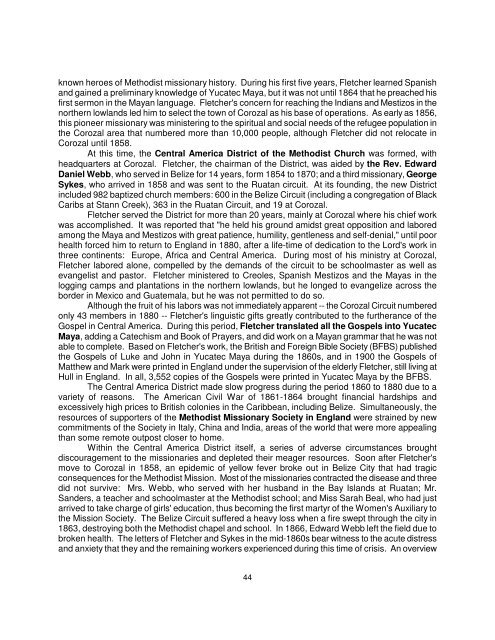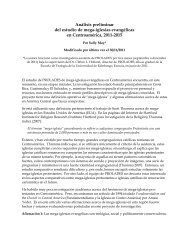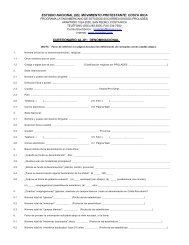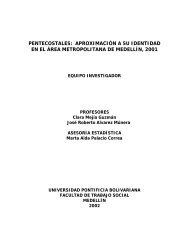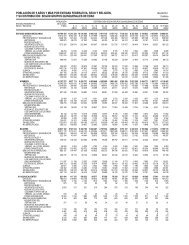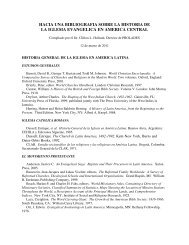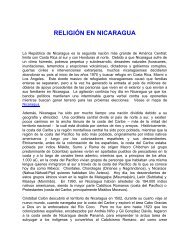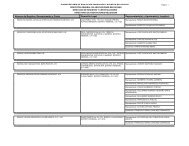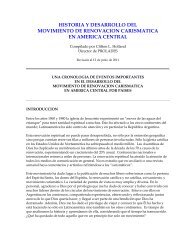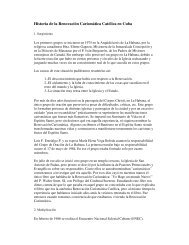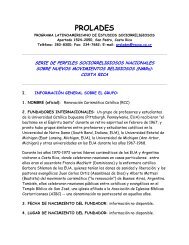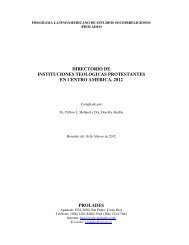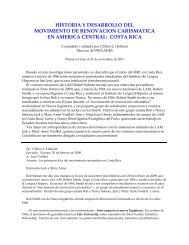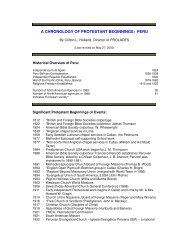belize, 1980 - Prolades.com
belize, 1980 - Prolades.com
belize, 1980 - Prolades.com
You also want an ePaper? Increase the reach of your titles
YUMPU automatically turns print PDFs into web optimized ePapers that Google loves.
known heroes of Methodist missionary history. During his first five years, Fletcher learned Spanish<br />
and gained a preliminary knowledge of Yucatec Maya, but it was not until 1864 that he preached his<br />
first sermon in the Mayan language. Fletcher's concern for reaching the Indians and Mestizos in the<br />
northern lowlands led him to select the town of Corozal as his base of operations. As early as 1856,<br />
this pioneer missionary was ministering to the spiritual and social needs of the refugee population in<br />
the Corozal area that numbered more than 10,000 people, although Fletcher did not relocate in<br />
Corozal until 1858.<br />
At this time, the Central America District of the Methodist Church was formed, with<br />
headquarters at Corozal. Fletcher, the chairman of the District, was aided by the Rev. Edward<br />
Daniel Webb, who served in Belize for 14 years, form 1854 to 1870; and a third missionary, George<br />
Sykes, who arrived in 1858 and was sent to the Ruatan circuit. At its founding, the new District<br />
included 982 baptized church members: 600 in the Belize Circuit (including a congregation of Black<br />
Caribs at Stann Creek), 363 in the Ruatan Circuit, and 19 at Corozal.<br />
Fletcher served the District for more than 20 years, mainly at Corozal where his chief work<br />
was ac<strong>com</strong>plished. It was reported that "he held his ground amidst great opposition and labored<br />
among the Maya and Mestizos with great patience, humility, gentleness and self-denial," until poor<br />
health forced him to return to England in 1880, after a life-time of dedication to the Lord's work in<br />
three continents: Europe, Africa and Central America. During most of his ministry at Corozal,<br />
Fletcher labored alone, <strong>com</strong>pelled by the demands of the circuit to be schoolmaster as well as<br />
evangelist and pastor. Fletcher ministered to Creoles, Spanish Mestizos and the Mayas in the<br />
logging camps and plantations in the northern lowlands, but he longed to evangelize across the<br />
border in Mexico and Guatemala, but he was not permitted to do so.<br />
Although the fruit of his labors was not immediately apparent -- the Corozal Circuit numbered<br />
only 43 members in 1880 -- Fletcher's linguistic gifts greatly contributed to the furtherance of the<br />
Gospel in Central America. During this period, Fletcher translated all the Gospels into Yucatec<br />
Maya, adding a Catechism and Book of Prayers, and did work on a Mayan grammar that he was not<br />
able to <strong>com</strong>plete. Based on Fletcher's work, the British and Foreign Bible Society (BFBS) published<br />
the Gospels of Luke and John in Yucatec Maya during the 1860s, and in 1900 the Gospels of<br />
Matthew and Mark were printed in England under the supervision of the elderly Fletcher, still living at<br />
Hull in England. In all, 3,552 copies of the Gospels were printed in Yucatec Maya by the BFBS.<br />
The Central America District made slow progress during the period 1860 to 1880 due to a<br />
variety of reasons. The American Civil War of 1861-1864 brought financial hardships and<br />
excessively high prices to British colonies in the Caribbean, including Belize. Simultaneously, the<br />
resources of supporters of the Methodist Missionary Society in England were strained by new<br />
<strong>com</strong>mitments of the Society in Italy, China and India, areas of the world that were more appealing<br />
than some remote outpost closer to home.<br />
Within the Central America District itself, a series of adverse circumstances brought<br />
discouragement to the missionaries and depleted their meager resources. Soon after Fletcher's<br />
move to Corozal in 1858, an epidemic of yellow fever broke out in Belize City that had tragic<br />
consequences for the Methodist Mission. Most of the missionaries contracted the disease and three<br />
did not survive: Mrs. Webb, who served with her husband in the Bay Islands at Ruatan; Mr.<br />
Sanders, a teacher and schoolmaster at the Methodist school; and Miss Sarah Beal, who had just<br />
arrived to take charge of girls' education, thus be<strong>com</strong>ing the first martyr of the Women's Auxiliary to<br />
the Mission Society. The Belize Circuit suffered a heavy loss when a fire swept through the city in<br />
1863, destroying both the Methodist chapel and school. In 1866, Edward Webb left the field due to<br />
broken health. The letters of Fletcher and Sykes in the mid-1860s bear witness to the acute distress<br />
and anxiety that they and the remaining workers experienced during this time of crisis. An overview<br />
44


